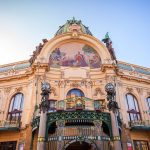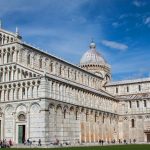According to the World Tourism Organization, Russia was the sixteenth-most visited country in the world, and the tenth-most visited country in Europe, in 2018, with over 24.6 million visits. Russia was ranked 39th in the Travel and Tourism Competitiveness Report 2019.According to Federal Agency for Tourism, the number of inbound trips of foreign citizens to Russia amounted to 24.4 million in 2019. Russia’s international tourism receipts in 2018 amounted to $11.6 billion. In 2019, travel and tourism accounted for about 4.8% of country’s total GDP.
Major tourist routes in Russia include a journey around the Golden Ring of Russia, a theme route of ancient Russian cities, cruises on large rivers such as the Volga, hikes on mountain ranges such as the Caucasus Mountains, and journeys on the famous Trans-Siberian Railway. Russia’s most visited and popular landmarks include Red Square, the Peterhof Palace, the Kazan Kremlin, the Trinity Lavra of St. Sergius and Lake Baikal.
Moscow, the nation’s cosmopolitan capital and historic core, is a bustling megacity. It retains its classical and Soviet-era architecture; while boasting high art, world class ballet, and modern skyscrapers. Saint Petersburg, the Imperial capital, is famous for its classical architecture, cathedrals, museums and theatres, white nights, criss-crossing rivers and numerous canals.Russia is famed worldwide for its rich museums, such as the State Russian, the State Hermitage, and the Tretyakov Gallery; and for theatres such as the Bolshoi and the Mariinsky. The Moscow Kremlin and the Saint Basil’s Cathedral are among the cultural landmarks of Russia.
1.Trans-Siberian Railway

The railway is often associated with the main transcontinental Russian line that connects hundreds of large and small cities of the European and Asian parts of Russia. At a Moscow–Vladivostok track length of 9,289 kilometres (5,772 miles), it spans a record eight time zones. Taking eight days to complete the journey, it is the third-longest single continuous service in the world, after the Moscow–Pyongyang 10,267 kilometres (6,380 mi)and the Kyiv–Vladivostok 11,085 kilometres (6,888 mi) services, both of which also follow the Trans-Siberian for much of their routes.
The main route of the Trans-Siberian Railway begins in Moscow at Yaroslavsky Vokzal, runs through Yaroslavl or Chelyabinsk, Omsk, Novosibirsk, Krasnoyarsk, Irkutsk, Ulan-Ude, Chita, and Khabarovsk to Vladivostok via southern Siberia. A second primary route is the Trans-Manchurian, which coincides with the Trans-Siberian east of Chita as far as Tarskaya (a stop 12 km (7 mi) east of Karymskoye, in Chita Oblast), about 1,000 km (621 mi) east of Lake Baikal. From Tarskaya the Trans-Manchurian heads southeast, via Harbin and Mudanjiang in China’s Northeastern Provinces (from where a connection to Beijing is used by one of the Moscow–Beijing trains), joining with the main route in Ussuriysk just north of Vladivostok. This is the shortest and the oldest railway route to Vladivostok. While there are currently no traverse passenger services (enter China from one side and then exit China and return to Russia on the other side) on this branch, it is still used by several international passenger services between Russia and China.
2.Mount Elbrus

Mount Elbrus is the highest and most prominent peak in Russia and Europe. It is situated in the western part of the Caucasus and is the highest peak of the Caucasus Mountains.
The name Elbrus /ˈɛlbrəs/ seems to have a connection with Alborz (also called Elburz), which is also the name of a long mountain range in northern Iran, but the two should not be confused. The name is derived from Avestan Harā Bərəzaitī, a legendary mountain in Iranian mythology. Harā Bərəzaitī reflects Proto-Iranian *Harā Bṛzatī, which was reformed into Middle Persian as Harborz, and into Modern Persian as Alborz. Bṛzatī is the feminine form of the adjective *bṛzant (“high”), the reconstructed ancestor of Modern Ossetian bærzond (“high”, “peak”), Modern Persian barz (“high”), berāzande (“elegant”), and boland (“high”, “tall”), and Modern Kurdish barz (“high”). Harā may be interpreted as “watch” or “guard”, from Indo-European *ser (“protect”). The name “Mingi Taw” used by Karachays and Balkars means “Eternal Mountain” in Turkic.
At 5,642 meters (18,510 ft), Elbrus is included as one of the Seven Summits, the highest summits on each of the planet’s seven continents, attracting both experienced and novice mountain climbers. While the mountain was formed from a volcano, it is considered dormant, with no recorded eruptions. A cable car system can take visitors as high as 3,800 meters (12,500 ft), facilitating ascents to the summit.
3. Kizhi Island

Kizhi is an island near the geometrical center of the Lake Onega in the Republic of Karelia, Russia. It is elongated from north to south and is about 6 km long, 1 km wide and is about 68 km away from the capital of Karelia, Petrozavodsk. Settlements and churches on the island were known from at least the 15th century.
Settlements and churches on the island were known from at least the 15th century. The population was rural, but was forced by the government to assist development of the ore mining and iron plants in the area that resulted in a major Kizhi Uprising in 1769–1771. Most villages had disappeared from the island by the 1950s and now only a small rural settlement remains. In the 18th century, two major churches and a bell tower were built on the island, which are now known as Kizhi Pogost. In the 1950s, dozens of historical wooden buildings were moved to the island from various parts of Karelia for preservation purposes. Nowadays, the entire island and the nearby area form a national open-air museum with more than 80 historical wooden structures. The most famous is the Kizhi Pogost, which is a UNESCO World Heritage site.
4.St Sophia Cathedral, Novgorod

The Cathedral of Holy Wisdom in Veliky Novgorod is the cathedral church of the Metropolitan of Novgorod and the mother church of the Novgorodian Eparchy.
Located in Novgorod, Russia’s oldest city, Saint Sophia Cathedral is situated within the grounds of the city’s Kremlin. Standing 125 feet high and adorned with five spectacular domes, the cathedral is the oldest church building in Russia. Saint Sophia Cathedral features an array of ancient religious artifacts, including The Mother of God of the Sign, an icon that legend says saved Novgorod from attack in 1169. The cathedral’s three famous ornately carved gates also date back to the 12th century.
Novgorod’s St. Sophia was the first Slavic church in which local divergences from Byzantine pattern were made so evident. With its austere walls, narrow windows, the church is redolent of Romanesque architecture of Western Europe, rather than of Greek churches built at that time.
The Novgorod cathedral also differs strikingly from its namesake and contemporary in Kiev. As one art historian put it, the Kiev cathedral is a bride, whereas the Novgorod cathedral is a warrior. Its decoration is minimal, the use of brick is limited, and the masses are arranged vertically rather than horizontally. These features proved to be influential with Novgorod masters of the next generation, as the Yuriev Monastery Cathedral (1119) and the Antoniev Monastery Cathedral (1117) clearly show.
5.Suzdal

Once the capital of several Russian principalities, Suzdal is the jewel of Russia’s “Golden Ring,” ancient cities that the country has preserved as living museums of Russia’s cultural past. Those who wish to experience the best of Russia’s historic architecture, full of onion-dome topped kremlins, cathedrals and monasteries, will find it in Suzdal. Dating back to 1024, the entire city is like a large open-air museum that transports visitors back in time.
Within its ramparts, the Cathedral of the Nativity has gold-starred domes and 13th-century frescoes. The Archbishop’s Chambers has striking 15th-century icons. North, the Monastery of St. Euthymius features the white stone Transfiguration Cathedral and history exhibits.
The only industry in the town is tourism. Suzdal avoided the industrialisation of the Soviet times and was able to preserve a great number of stunning examples of the Russian architecture of the 13th-19th century. There are 305 monuments and listed buildings in Suzdal, including 30 churches, 14 bell towers and 5 monasteries and convents. 79 of them are federally protected buildings and 167 are regionally protected.
In 1992 two of the monuments (Saviour Monastery of St Euthymius and Kremlin with Nativity of the Virgin Cathedral) were included in the UNESCO World Heritage List, together with six other White Monuments in this region.
6.Moscow Kremlin

The Kremlin is a fortified complex in the centre of Moscow founded by the Rurikids ruling dynasty. It is the best known of the kremlins, and includes five palaces, four cathedrals, and the enclosing Kremlin Wall with Kremlin towers.
The Kremlin is a must-see attraction for anyone visiting Moscow. Home to the nation’s top governmental offices, the walled enclosure also houses four cathedrals built in the 15th and 16th century as well as several notable museums. The 250-acre grounds include the Armoury, filled with royal treasures of the past, and the Diamond Fund Exhibition, a collection of jewelry that includes a 190-carat diamond given to Catherine the Great.
Dmitri Donskoi replaced the oak walls with a strong citadel of white limestone in 1366–1368 on the basic foundations of the current walls; this fortification withstood a siege by Khan Tokhtamysh. Dmitri’s son Vasily I resumed construction of churches and cloisters in the Kremlin. The newly built Cathedral of the Annunciation was painted by Theophanes the Greek, Andrei Rublev, and Prokhor in 1406. The Chudov Monastery was founded by Dmitri’s tutor, Metropolitan Alexis; while his widow, Eudoxia, established the Ascension Convent in 1397.
7.Saint Basil’s Cathedral

Built between 1554 and 1561 and situated in the heart of Moscow, St. Basil’s Cathedral has been among the top tourist attractions in Russia. It is not the building’s interior artifacts that attract visitors, but rather the cathedral’s distinctive architecture. Designed to resemble the shape of a bonfire in full flame, the architecture is not only unique to the period in which it was built but to any subsequent period. There is no other structure on earth quite like St. Basil’s Cathedral.
The original building, known as Trinity Church and later Trinity Cathedral, contained eight chapels arranged around a ninth, central chapel dedicated to the Intercession; a tenth chapel was erected in 1588 over the grave of the venerated local saint Vasily (Basil). In the 16th and 17th centuries, the church, perceived (as with all churches in Byzantine Christianity) as the earthly symbol of the Heavenly City, was popularly known as the “Jerusalem” and served as an allegory of the Jerusalem Temple in the annual Palm Sunday parade attended by the Patriarch of Moscow and the Tsar.









